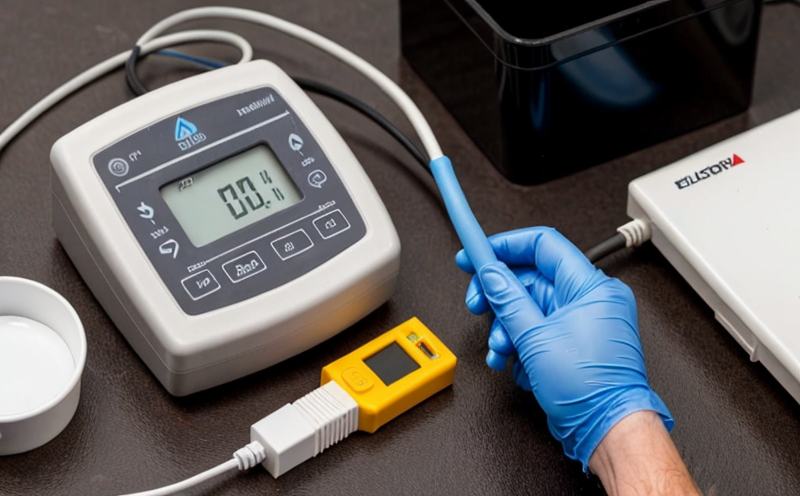ASTM G106 Electrochemical Potentiostatic Testing
The ASTM G106 standard specifies potentiostatic polarization testing methods to determine pitting corrosion resistance of stainless steels and other materials. This testing is critical for understanding the behavior of materials in various environments, particularly where localized corrosion can lead to catastrophic failures.
ASTM G106 Electrochemical Potentiostatic Testing is widely used across industries such as aerospace, automotive, chemical processing, and marine engineering. The primary objective is to evaluate a material's resistance against pitting corrosion under controlled conditions. The test simulates real-world environments where localized corrosion can occur, providing insights into the material's performance in these harsh conditions.
The testing process involves exposing the specimen to an electrolyte solution while applying a constant voltage (potentiostatic) to the sample and reference electrode. This setup allows for precise control over the electrochemical potential and current flow. The test is conducted at specific potentials, typically ranging from -200 mV to +100 mV with respect to the open circuit potential of the specimen. Throughout the test duration, data on polarization resistance (Rp), anodic and cathodic Tafel slopes, and pitting corrosion parameters are recorded.
The specimen preparation is crucial for accurate testing results. Samples should be free from defects and contamination, with a polished surface finish to ensure consistent electrical contact. The sample is typically cut into discs or strips of standardized dimensions, ensuring uniformity across tests. Prior to testing, the specimens are cleaned using appropriate methods such as ultrasonic cleaning in an alcohol solution followed by drying under nitrogen.
The test setup includes specialized equipment designed for potentiostatic polarization testing. Instruments like the Potentiostat/Galvanostat (PG STAT) and Reference Electrode are essential components. The Potentiostat/Galvanostat provides precise control over the applied voltage, while the reference electrode ensures accurate measurement of the electrochemical potential. Additionally, a three-electrode cell is used, consisting of the specimen, reference electrode, and counter electrode.
The testing environment must be controlled to ensure consistent results. This includes maintaining temperature stability within ±0.1°C, humidity levels at 50% RH ±2%, and ensuring that the electrolyte solution is prepared according to ASTM G106 specifications. The test duration can vary depending on the material being tested; however, a typical test period ranges from several hours to up to three days.
The results of the ASTM G106 test are presented in various forms including graphs and tables summarizing polarization curves, Tafel slopes, Rp values, pitting corrosion thresholds, and other relevant parameters. These data points help in assessing the susceptibility of materials to localized corrosion and guide material selection for critical applications.
ASTM G106 Electrochemical Potentiostatic Testing is essential for ensuring product quality and reliability by providing insights into potential corrosion risks early in the development process. This testing method supports compliance with international standards, enabling companies to meet regulatory requirements and improve overall product performance.
Environmental and Sustainability Contributions
- By identifying materials resistant to pitting corrosion, this test helps reduce waste by preventing premature failures of components leading to extended service life.
- The data obtained from ASTM G106 contributes to the design of more durable products, ultimately reducing resource consumption and energy usage throughout a product's lifecycle.
Use Cases and Application Examples
- In aerospace applications, where lightweight yet strong materials are essential for fuel efficiency and safety, ASTM G106 helps select the most suitable stainless steel alloys for critical components like fasteners and structural elements.
- In marine engineering, this test ensures that materials used in hulls and piping systems can withstand harsh saltwater environments without succumbing to pitting corrosion.
Why Choose This Test
The ASTM G106 Electrochemical Potentiostatic Testing offers several advantages over other methods of assessing material resistance to pitting corrosion. Firstly, it provides quantitative data on the critical pitting potential (Ecp) and polarization resistance (Rp), which are key indicators of a material's susceptibility to pitting.
Secondly, this test allows for detailed analysis of Tafel slopes and current density distribution, offering deeper insights into the electrochemical behavior of materials. This information is invaluable for R&D teams looking to improve material formulations or modify existing designs.
Additionally, ASTM G106 testing is well-suited for comparing different materials under controlled conditions, enabling informed decisions about material selection based on real-world performance data. The standardized procedure ensures consistency across labs and facilities, facilitating better communication between suppliers, manufacturers, and end-users.
Compliance with ASTM standards also enhances a company's reputation by demonstrating commitment to quality and adherence to international best practices. This can be particularly beneficial when bidding for contracts or entering new markets where stringent regulatory requirements are in place.





